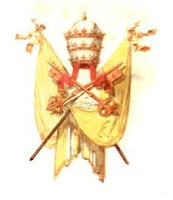VON BALTHASAR attempts to reconcile both freedom (autonomy) and obedience (to law,i.e., heteronomy) by focusing on the "gift" aspect of one's relationship when confronting beauty, a confrontation that demands a sort of fitting response. For von Balthasar, there is no such thing as an autonomous self that lives apart from others. For him, "autonomy emerges not in isolation from the other, but only in an engagement with the other." Steck, 27.
Steck,27. Beauty is what takes us out of our solipsistic shell. It nudges us, as it were, to give a response, to act outside of ourselves, to love something outside of and extrinsic to us, and in so doing, we exercise our freedom. Beauty, and the response it elicits, is thus "freedom-granting." "In the 'seeing' of beauty, the subject breaks out of the self-enclosed sphere of nonfreedom into the expansive horizon of love." Steck, 27. Therefore, the "obedience" of love is not restrictive, but exactly the opposite: freeing. It opens us to truth, to good, and it is only in truth and good that we find freedom.
This response is at its acme when one is dealing with an interpersonal encounter, as distinguished from the encounter between a person and a thing. It is one thing to love a painting by Cézanne; it is altogether something else to confront Cézanne himself. In an interpersonal encounter, the response to gift is mutual and so there is a mutual increase of freedom and a mutual obedience of love. Of course, for von Balthasar the Christian, nowhere is this more manifest than in the interpersonal relations with the Father, Son, and Holy Spirit. Indeed, it is precisely this infinite and eternal interpersonal intercommunication that is found within man, the image of God, in a created manner. There is within man, therefore, a shimmer of God's glory. He enjoys a "theological beauty" which is both ontological and relational.
God's glory is found in the human person in two ways according to von Balthasar, ontologically and relationally. First, ontologically, man's shimmer of God's glory is found in the fact that he is made in the image of God. Within the human person, God "has 'set an image of himself over against himself,' which, because it resembles the archetype, has 'certain traits of glory . . . . intrinsically . . . proper to it.'" Steck, 29 (quoting GL6.15) This glory "proper" to man is bipartite. First, it involves a capacity for free, that is, autonomous, self-expression. Second, it involves a sort of stewardship of "lordship" in that man becomes an agent, as it were, of God, a "'representative of God and of God's power as rule.'" Steck, 29 (quoting GL6.91) Man, therefore, has a "theological beauty," a scintilla of God's glory. And this "theological beauty" appears in all men irrespective of creed. It is a natural quality, not a supernatural quality.
This gives man a certain standing before God. "This sphere of lordship allow the human person be other before God without ever being absolute other." Steck, 29. Man's "lordship" is sub Deo et lege, under God and law.
The second way in which God's glory appears in man (and which is part of his "theological beauty") relational. It arises out of man's ability to form a communion of persons, an "I-Thou" encounter. This quality is, of course, directly tied to man as imago Dei. It is, in fact, a necessary component of the human person. "For von Balthasar, the human person is always a being-in-relationship; in being what we are, we are being with others." Steck, 30.
It is the second, relational aspect of man that is "the privileged moment of the manifestation of God's glory." The ontological aspect is in fact supportive of the relational aspect. This is true not only in terms of natural relationships between two human persons, but eminently so in the case of a human person's relationship with God in Jesus. Here, the contingent, created theological glory of man comes face to face with the human face of God in Jesus, a most incarnational manifestation of God's uncreated glory. In relating to God it is created glory responding to uncreated glory.
For von Balthasar, the normative, moral framework for freedom, at least on the intramundane level, lies in the contours and dynamics of the subject/object encounter viewed aesthetically. Our self-expressiveness only becomes expression, visible as beautiful and free human form, through obedience to the normative forms of human action.
Steck,27. Beauty is what takes us out of our solipsistic shell. It nudges us, as it were, to give a response, to act outside of ourselves, to love something outside of and extrinsic to us, and in so doing, we exercise our freedom. Beauty, and the response it elicits, is thus "freedom-granting." "In the 'seeing' of beauty, the subject breaks out of the self-enclosed sphere of nonfreedom into the expansive horizon of love." Steck, 27. Therefore, the "obedience" of love is not restrictive, but exactly the opposite: freeing. It opens us to truth, to good, and it is only in truth and good that we find freedom.
This response is at its acme when one is dealing with an interpersonal encounter, as distinguished from the encounter between a person and a thing. It is one thing to love a painting by Cézanne; it is altogether something else to confront Cézanne himself. In an interpersonal encounter, the response to gift is mutual and so there is a mutual increase of freedom and a mutual obedience of love. Of course, for von Balthasar the Christian, nowhere is this more manifest than in the interpersonal relations with the Father, Son, and Holy Spirit. Indeed, it is precisely this infinite and eternal interpersonal intercommunication that is found within man, the image of God, in a created manner. There is within man, therefore, a shimmer of God's glory. He enjoys a "theological beauty" which is both ontological and relational.
God's glory is found in the human person in two ways according to von Balthasar, ontologically and relationally. First, ontologically, man's shimmer of God's glory is found in the fact that he is made in the image of God. Within the human person, God "has 'set an image of himself over against himself,' which, because it resembles the archetype, has 'certain traits of glory . . . . intrinsically . . . proper to it.'" Steck, 29 (quoting GL6.15) This glory "proper" to man is bipartite. First, it involves a capacity for free, that is, autonomous, self-expression. Second, it involves a sort of stewardship of "lordship" in that man becomes an agent, as it were, of God, a "'representative of God and of God's power as rule.'" Steck, 29 (quoting GL6.91) Man, therefore, has a "theological beauty," a scintilla of God's glory. And this "theological beauty" appears in all men irrespective of creed. It is a natural quality, not a supernatural quality.
This gives man a certain standing before God. "This sphere of lordship allow the human person be other before God without ever being absolute other." Steck, 29. Man's "lordship" is sub Deo et lege, under God and law.
The second way in which God's glory appears in man (and which is part of his "theological beauty") relational. It arises out of man's ability to form a communion of persons, an "I-Thou" encounter. This quality is, of course, directly tied to man as imago Dei. It is, in fact, a necessary component of the human person. "For von Balthasar, the human person is always a being-in-relationship; in being what we are, we are being with others." Steck, 30.
It is the second, relational aspect of man that is "the privileged moment of the manifestation of God's glory." The ontological aspect is in fact supportive of the relational aspect. This is true not only in terms of natural relationships between two human persons, but eminently so in the case of a human person's relationship with God in Jesus. Here, the contingent, created theological glory of man comes face to face with the human face of God in Jesus, a most incarnational manifestation of God's uncreated glory. In relating to God it is created glory responding to uncreated glory.




No comments:
Post a Comment